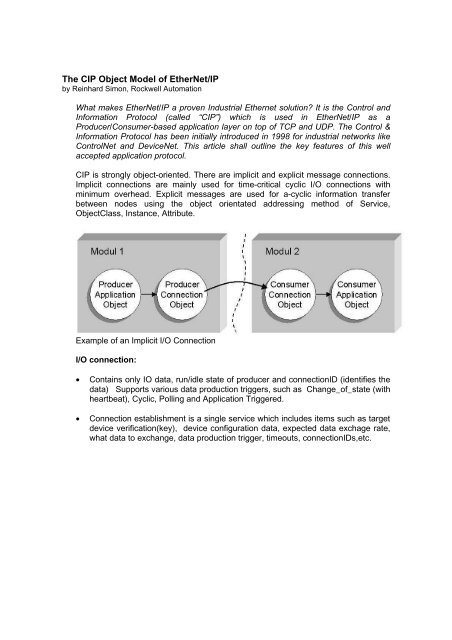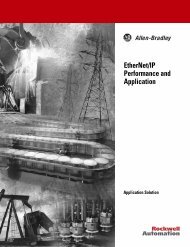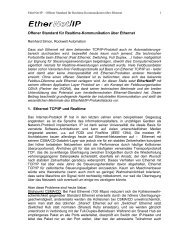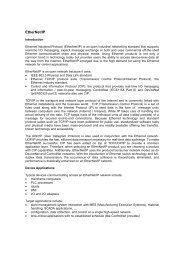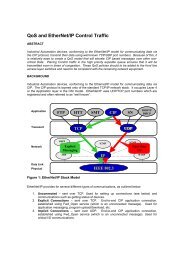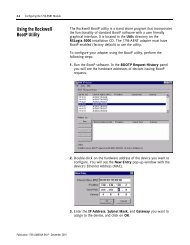The CIP Object Model of EtherNet/IP - ODVA
The CIP Object Model of EtherNet/IP - ODVA
The CIP Object Model of EtherNet/IP - ODVA
Create successful ePaper yourself
Turn your PDF publications into a flip-book with our unique Google optimized e-Paper software.
<strong>The</strong> <strong>C<strong>IP</strong></strong> <strong>Object</strong> <strong>Model</strong> <strong>of</strong> <strong>EtherNet</strong>/<strong>IP</strong><br />
by Reinhard Simon, Rockwell Automation<br />
What makes <strong>EtherNet</strong>/<strong>IP</strong> a proven Industrial Ethernet solution? It is the Control and<br />
Information Protocol (called “<strong>C<strong>IP</strong></strong>”) which is used in <strong>EtherNet</strong>/<strong>IP</strong> as a<br />
Producer/Consumer-based application layer on top <strong>of</strong> TCP and UDP. <strong>The</strong> Control &<br />
Information Protocol has been initially introduced in 1998 for industrial networks like<br />
ControlNet and DeviceNet. This article shall outline the key features <strong>of</strong> this well<br />
accepted application protocol.<br />
<strong>C<strong>IP</strong></strong> is strongly object-oriented. <strong>The</strong>re are implicit and explicit message connections.<br />
Implicit connections are mainly used for time-critical cyclic I/O connections with<br />
minimum overhead. Explicit messages are used for a-cyclic information transfer<br />
between nodes using the object orientated addressing method <strong>of</strong> Service,<br />
<strong>Object</strong>Class, Instance, Attribute.<br />
Example <strong>of</strong> an Implicit I/O Connection<br />
I/O connection:<br />
• Contains only IO data, run/idle state <strong>of</strong> producer and connectionID (identifies the<br />
data) Supports various data production triggers, such as Change_<strong>of</strong>_state (with<br />
heartbeat), Cyclic, Polling and Application Triggered.<br />
• Connection establishment is a single service which includes items such as target<br />
device verification(key), device configuration data, expected data exchage rate,<br />
what data to exchange, data production trigger, timeouts, connectionIDs,etc.
<strong>The</strong> <strong>Object</strong> <strong>Model</strong>:<br />
Application<br />
<strong>Object</strong>s (device<br />
specific)<br />
This model is interesting for developers only, a user would not have to care about object<br />
model relations. For a user, it is much more interesting to refer to Device Pr<strong>of</strong>iles. A<br />
motor drive device for instance with a certain device pr<strong>of</strong>ile has required objects with<br />
real-time attributes like current, torque and configuration attributes like “accel”, “decel”,<br />
overload settings and others which exactly describe the device features and I/O data<br />
exchange. This provides a mechanism for multi-vendor interchangeability with simple<br />
devices. Devices for which there is no pr<strong>of</strong>ile already defined, can be built as a Generic<br />
Device, which would contain all the <strong>EtherNet</strong>/<strong>IP</strong> minimum requirements, as well as any<br />
additional public objects (from the spec’s object library) and vendor specific objects.<br />
While it is quite easy and flexible to adopt end devices to this model and also to<br />
generate a conformance qualification, it is more complicated to do this for a scanner<br />
class device (requires EML master library). <strong>The</strong>re are electronic data files (EDS) which<br />
describe the device behavior and features. This allows configuration tools to easily adapt<br />
to new devices and provides for both online and <strong>of</strong>fline configuration.<br />
Simple devices can live with quite compact memory requirements (in DeviceNet’s <strong>C<strong>IP</strong></strong><br />
implementation small nodes could run with a few KBytes <strong>of</strong> memory in a limited model<br />
but that is not supported in <strong>EtherNet</strong>/<strong>IP</strong>). Even if the application is not master/slave<br />
related and the producer/model would not really require a scanner (master), there is a<br />
practical need for more memory in at least one <strong>of</strong> the nodes to hold basic information<br />
about the overall Ethernet connections etc. In practice, this is normally covered in a<br />
scanner class device. In the future, as the cost <strong>of</strong> CPU power and memory decreases<br />
more peer to peer (distributed) control is expected to occur.<br />
Application <strong>Object</strong>s are device specific. <strong>The</strong>y include all code and information related to<br />
individual device functions and provide a good base for distributed automation
applications. Assembly objects may be fixed or variable. A fixed assembly object for<br />
instance is an I/O block with predefined functionality (its member list consisting <strong>of</strong><br />
attributes from various objects within the device is fixed). Devices can optionally support<br />
dynamic assembly objects and can be set up individually.<br />
Other applications based on the TCP/<strong>IP</strong> protocol suite may run in parallel with <strong>C<strong>IP</strong></strong> (such<br />
as FTP, SNMP, HTTP, …). For file transfer it is possible to use standard FTP<br />
client/server connections besides <strong>C<strong>IP</strong></strong>, or as an option use the File <strong>Object</strong> which is<br />
planned as a future part <strong>of</strong> <strong>C<strong>IP</strong></strong>.<br />
Name spaces in the application object: <strong>C<strong>IP</strong></strong> allows user assigned symbolic names and/or<br />
vendor assigned symbolic names to logical addresses (object class/instance/attribute) .<br />
Even though symbolic names may be the same in more than one device (for example,<br />
as named by the user, or the SPEED setting attribute in two different drives,), they are<br />
guaranteed to be uniquely addressable from the protocol level, as node number/name<br />
and device identity are checked as part <strong>of</strong> establishing a connection.<br />
Example<br />
PLC #1 PLC #2<br />
Assembly<br />
<strong>Object</strong> #1<br />
Connection Management<br />
Assembly<br />
<strong>Object</strong> #1<br />
PLC #3<br />
Quality <strong>of</strong> Service: <strong>C<strong>IP</strong></strong> has several priority levels as part <strong>of</strong> its connection establishment<br />
but there is need for additional prioritization on Ethernet - however this is beyond the<br />
scope <strong>of</strong> <strong>C<strong>IP</strong></strong>. <strong>C<strong>IP</strong></strong> priority levels are planned to be mapped in the future to the emerging<br />
IEEE802.1p Frame Prioritization standard (8 levels). It is just now being supported by<br />
switches, but also needs to be supported by TCP/<strong>IP</strong> stacks and by an IETF (or similar)<br />
standard that defines how these are to be applied to applications (email, ftp, video<br />
conferencing, control, Voice Over <strong>IP</strong>, etc. <strong>The</strong>n the mapping <strong>of</strong> <strong>C<strong>IP</strong></strong> priority levels can be<br />
directly mapped to the 801.2p levels. Quality <strong>of</strong> Service to prioritize between <strong>C<strong>IP</strong></strong> I/O<br />
messages and other UDP and TCP messages is therefore not covered yet in<br />
<strong>EtherNet</strong>/<strong>IP</strong> (a so called “white spot”).<br />
<strong>IP</strong> Configuration: Assignment <strong>of</strong> <strong>IP</strong> addresses is not part <strong>of</strong> the <strong>C<strong>IP</strong></strong> layers, today this is<br />
covered by a DHCP or BootP server installed in the network. For automation
applications there is a need for user-friendly assignment <strong>of</strong> <strong>IP</strong> addresses when devices<br />
are replaced on the factory floor. Special configuration tools will care for this.<br />
Regarding “Multicast over Ethernet” there is discussion about how multicast should be<br />
applied. With <strong>C<strong>IP</strong></strong> multicast is primarily related to I/O messages (over UDP/<strong>IP</strong>). Until<br />
routers become faster with less jitter, <strong>ODVA</strong> and CI feel it is important to recommend to<br />
users that multicast connections should not cross routers into other subnets.<br />
Within <strong>C<strong>IP</strong></strong> there will also be safety related objects (as announced by <strong>ODVA</strong> for<br />
DeviceNet Safety, a <strong>C<strong>IP</strong></strong> based safety concept has been approved by TÜV and BIA),<br />
these safety services and objects are media independent and will also be applicable on<br />
<strong>EtherNet</strong>/<strong>IP</strong> in future.<br />
Source: <strong>ODVA</strong>


